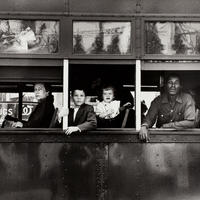More about Robert Frank
- All
- Info
- Shop
Works by Robert Frank

Adjunct Instructor, Forsyth Technical Community College
Robert Frank is the embodiment of the independent, hedonist, Beat generation dream.
Despite resistance and criticism to his snapshot aesthetic, Frank’s photography set the standard of capturing reality in documentary photography.
Robert Frank found a love for photography during World War II in Switzerland. His neutral Swiss family was safe during the war, but news of it permeated their daily life with sadness. The looming conflict and loneliness influenced his worldview for years. The bit of joy he did find was from his father’s Sunday hobby, photography. Like any rebellious child, he pursued his artistic passions as a career, something his father did not encourage. Frank worked in Zurich’s fashion industry before moving to New York City in the early 1950s to pursue fashion photography at Harper’s Bazaar.
America represented a sense of freedom for Frank - from his family, the war-torn landscape, and even artistically. He used his Leica in the studio, where a 35mm camera was highly unusual. Much of his work was described by outsiders as grainy, blurry, and looking like anyone’s kid could have done it - very similar to the continued perspective of Jackson Pollock. After only a few months at Harper’s, Frank quit to instead pursue freelance photography as he found the traditional fashion world stifling. He worked for popular magazines at the time including Look, LIFE, and Vogue.
On the side, Frank captured post-war life in all of its emotions through his street photography practice. He truly entered the New York art scene and became chummy with many artists including Willem de Kooning, Walker Evans, and Franz Kline. Frank’s photographs were lauded by fellow artists for capturing life as it was, not as an idealized version. He fully drank the Kool-Aid of the Beat generations’ manifesto, rebelling against consumerism, capitalism, and the increasingly conservative push of post-war America. Evans mentored Frank in the ways of photography and critiquing society by writing a recommendation letter for the Guggenheim Fellowship in 1955. With the Fellowship, Frank was able to complete his work for his monograph The Americans (not to be confused with the FX show).
Frank became the epitome of the Beat generation. Traveling across the country over two years, he would use his snapshot aesthetic to document American life not as it was advertised but as it truly was. He aimed his camera at the people and their experiences without a political or social guise of what it should be. While on his road trip, he was arrested in Arkansas on suspicion of spying, an accusation of many photographers. He was able to view America as an outsider, both the good and the bad. In 1958 The Americans was published, a monograph showing a fraction of Frank’s images. The French-published book received mass amounts of criticism from Americans, as it showed the true nature of the racist, sexist, and poverty stricken post-war country beneath its gleaming facade. Much of his American audience would have wanted to cancel him today, but Frank stood by his work and the grainy snapshot aesthetic influenced a new generation of photographers.
The snapshot aesthetic was not celebrated during Frank’s time. It gave photographs a look that anyone could take the image, all they had to do was point and shoot. The images were grainy, blurry, underexposed, and busy compositions, not like the clear, perfectly exposed and framed photographs with larger 4x5 cameras. His images had a relaxed style, one that did not look professional or serious to the public. While this caused a negative view of his images at the time, he became a photography influencer, still impacting the contemporary photography world.
Frank became a U.S. citizen in 1963. His last significant photography project was The Lines of my Hand, released in 1972. This was a semi-autobiographical series which included images from many of Frank’s travels. Afterwards, he felt he was finished with single images and moved on to the moving image. In 1972, he was asked by the Rolling Stones to create a documentary film about their tour. The film, Cocksucker Blues, was met with huge pushback from the band - they gave him a restraining order and a lawsuit outlined that the resulting unreleased film was only allowed to be shown four times a year and only with Frank in attendance. This continues to be a controversy in Frank’s career but the good kind that gets your work talked about. Frank continued to make photographs and films with other Beat generation artists. He passed away in 2019, but his legacy for the snapshot aesthetic and the Americans lives on.
Sources
- The Editors of Encyclopedia Britannica. Encyclopedia Britannica, November 5, 2021. https://www.britannica.com/biography/Robert-Frank.
- Gallun, Lucy. Robert Frank: Trolley - New Orleans. New York: Museum of Modern Art, 2021.
- Gefter, Philip. “Robert Frank Dies; Pivotal Documentary Photographer was 94.” New York Times, September 17, 2019. https://www.nytimes.com/2019/09/10/arts/robert-frank-dead-americans-pho….
Featured Content
Here is what Wikipedia says about Robert Frank
Robert Frank (November 9, 1924 – September 9, 2019) was a Swiss American photographer and documentary filmmaker. His most notable work, the 1958 book titled The Americans, earned Frank comparisons to a modern-day de Tocqueville for his fresh and nuanced outsider's view of American society. Critic Sean O'Hagan, writing in The Guardian in 2014, said The Americans "changed the nature of photography, what it could say and how it could say it. [ ... ] it remains perhaps the most influential photography book of the 20th century." Frank later expanded into film and video and experimented with manipulating photographs and photomontage.
Check out the full Wikipedia article about Robert Frank















